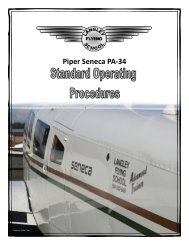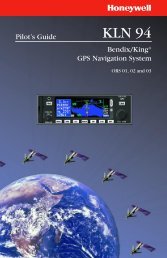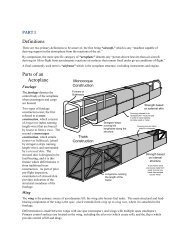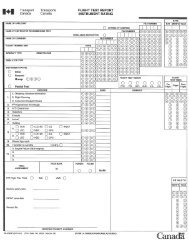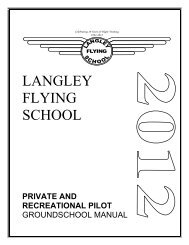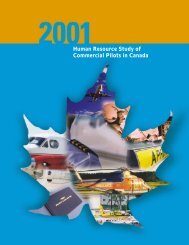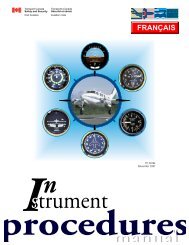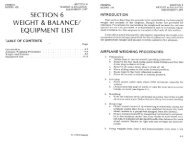LANGLEY FLYING SCHOOL Flight Training Handbook
LANGLEY FLYING SCHOOL Flight Training Handbook
LANGLEY FLYING SCHOOL Flight Training Handbook
Create successful ePaper yourself
Turn your PDF publications into a flip-book with our unique Google optimized e-Paper software.
<strong>Flight</strong> <strong>Training</strong> <strong>Handbook</strong> Page 22<br />
Langley Flying School, Inc.<br />
coasting. If required, of course, do not be afraid to lay into the brakes if rapid deceleration or directional control<br />
is required—but be sure the flaps are retracted and the control column is held back to produce maximum weight<br />
on the main gear for maximum braking.<br />
m) Use caution when opening the cabin door in a strong wind; the retention mechanism is easily broken if the door<br />
is wrenched open by the wind.<br />
n) Never leave a cabin door open, even in calm wind conditions; prop-wash from a taxiing aircraft could also<br />
damage the retention mechanism.<br />
o) Never leave a cabin door open while taxiing unless a person in the right seat is holding it securely (i.e., the<br />
Instructor).<br />
p) Remove the cabin covers with care so as not to hook the ambient temperature probe; the probe is mounted in the<br />
windscreen and a tugging force on the probe could crack the Plexiglas.<br />
q) Never place any metal objects—especially headsets—on top of the glareshield (dashboard), as the Plexiglas<br />
windscreen is easily scratched.<br />
Program Safety Rules and <strong>Flight</strong> Operations Notices<br />
Safety in flight training operations is founded on all persons knowing and abiding by rules and procedures. In<br />
particular, the <strong>Flight</strong> Rules and Safety Precautions described on P. 25 are crucial and must be complied with at all<br />
times. In addition, the <strong>Flight</strong> Instruction Staff publishes what are referred to as <strong>Flight</strong> Operation Notices and these<br />
appear in the front office near the booking sheet. The <strong>Flight</strong> Operations Notices serve the purpose of getting out<br />
critical safety and administrative information. Prior to being authorized to conduct a flight, all student pilots and<br />
pilots must have read and signed all of the current <strong>Flight</strong> Operations Notices.<br />
Commercial Students<br />
Many Commercial students will be quite surprised to learn that the flight test required for that licence is, indeed,<br />
virtually identical to the flight test they have just completed for their Private Pilot Licences. The only difference in<br />
the Commercial <strong>Flight</strong> Test is the addition of the accuracy approach, a spin demonstration, radio navigation, and<br />
limited panel instrument flying. Many in the flight training industry recognize the shortcomings of the current<br />
flight-test arrangement and there are plans in the works for Transport Canada to totally revise the Commercial Pilot<br />
training curriculum. In its current format, the Commercial Pilot Licence represents a step towards an Instrument<br />
Rating, which combined with a Multi-engine Class Rating, forms the most senior of Canadian—and indeed ICAO-<br />
Standard 9 pilot ratings—the Group 1 (Multi-engine) Instrument Rating. 10 To get the Instrument Rating, a candidate<br />
requires 40 hours of instrument flight training; 5 hours of these 40 hours are derived from Private Pilot <strong>Training</strong>, but<br />
the greatest portion is derived from Commercial Pilot <strong>Training</strong>, where a candidate is required to receive 20 hours of<br />
post-Private Pilot Licence <strong>Training</strong>.<br />
There should be no doubt, then, that Commercial Pilot <strong>Flight</strong> <strong>Training</strong> is really a stepping-stone to the Instrument<br />
Rating, and hopefully the Group 1 Instrument Rating. More significantly, however, the true demand for<br />
Commercial Pilots does not rest with the demand for pilots who possess just a Commercial Pilot Licence—there will<br />
always be jobs for these people, whether it is with small air-taxi operators and the so-called bush flying work. But<br />
there should be no doubt that the fast water in the flow of Commercial Pilot careers lies with the senior ratings, and<br />
ultimately, the Airline Transport Pilot Licence (ATPL). In this context, the Commercial Pilot Licence simply<br />
provides a means of getting off the shoreline—or more accurately, getting your feet wet in an entry-position flying<br />
job where single-engine day-VFR is practised. It is important to get this picture set in your mind: while there will<br />
always be demand for single-engine day-VFR flying—float flying is an example of this—the true potential in the<br />
future of aviation lies in the ability to safely transport people over large distances in the shortest possible period of<br />
time. Quite simple and obviously, the fast waters are for those with ATPLs. Of course, Langley Flying School’s<br />
role with respect to its Commercial Pilot Program is to train entry-level Commercial Pilots, and when we designed<br />
9 ICAO translates into the International Civil Aviation Organization, a United Nations affiliate that sets international standards in the field of<br />
aviation. The Private Pilot, Commercial Pilot, and Airline Transport Licences are ICAO-standard licences. The Multi-engine Instrument Rating<br />
is universally regarded as the prerequisite for the Airline Transport Licence.<br />
10 The Group 1 Instrument Rating is accomplished by successfully completing an Instrument Rating <strong>Flight</strong> Test in a multi-engine aircraft.<br />
2012 David L. Parry



